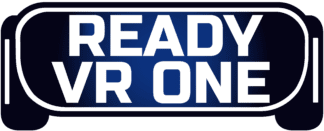- Solaris Offworld Combat Guide - July 29, 2022
- FNAF VR Guide - June 30, 2022
- Vivecraft vs Questcraft - June 26, 2022
Intro
Phasmophobia is a game known for being terrifying. I’ve definitely been spooked a few times! I remember being hunted in one of my first games and hiding in the corner next to a cabinet. Needless to say, I didn’t make it.
The game is especially spooky on VR, where you completely immerse yourself in the search for the paranormal. It can seem pretty complicated at times, and new players might not be sure where to begin. Naturally, that’s why I’m here!
I’m going to give you a comprehensive look into the world of Phasmophobia. I’m talking ghost types, equipment, maps, and everything you need to know to get the most out of being scared of your friendly neighborhood ghost.
Phasmophobia at a Glance
New players, this one’s for you. Think about the Ghostbusters for a second. Their job is to hunt down ghosts and capture them, right? Well, the ghost hunters in Phasmophobia are the pre-Ghostbusters. Your job in the game is to search an area for a ghost, collect all the evidence you can to prove its existence, and get out.
You, the brave pre-Ghostbuster risking your life for minimum wage, will catch ghosts by using various tools of the ghost-hunting trade. This includes cameras, flashlights, UV lights, Sound and motion detectors, etc. On a perfect day, you’ll make a mess of whatever haunted house you just walked into, discover a ghost and walk out with an increased chance of high blood pressure later in life. On a bad day, you’ll become well acquainted with the ghosts in the ghost dimension. What I mean by that is that you’ll die. That’s not good, as you can imagine. On the bright side, you can pick up objects and prank your friends!
Playing on VR
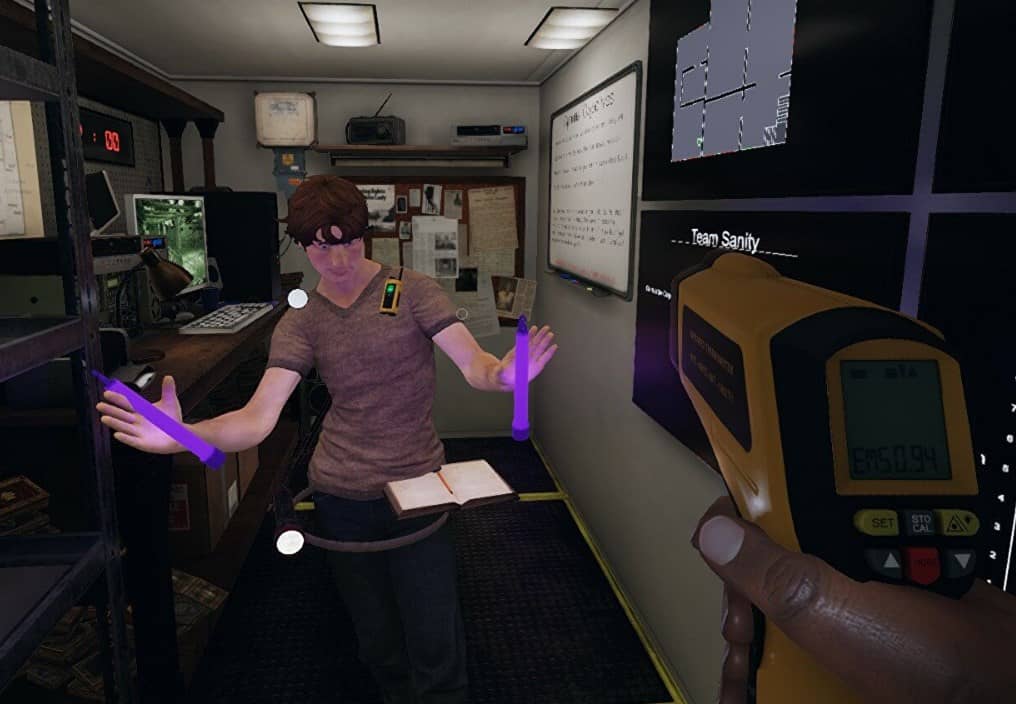
Phasmophobia on VR is very similar to the base game. The game’s structure is the same; the menu board is in the same place and is used in the same way you would on desktop, and everything else in a match is set up in the same way. The main difference between VR and desktop is how you control everything.
VR has a unique advantage over desktop in that you can carry more items. Desktop players can only take three items and use one equipment type at a time. VR players can carry four items (including two items on your belt and two in your hands) and use both hands to hold or toggle gear.
Phasmophobia VR has different control schemes depending on the controllers, but some things are consistent across multiple controllers:
Basic Movement: Generally, the left stick is used for movement, and the right one is used to turn. You can physically perform other basic actions, like crouching or looking around.
Local Chat: The VR version has local chat on by default, where desktop players have to use a key to talk locally.
Radio Chat: The radio can be grabbed from your belt or left shoulder and used by holding the trigger.
Journal: The Journal can be picked up from your belt or right shoulder. Use the trigger to navigate it.
Using Objects: Objects can be picked up by gripping the controller’s grip button and released by letting go of the button. Certain objects, like electronic equipment, can be activated using the trigger.
Something to note about using objects in VR: there’s a strange mechanic where you won’t be able to throw an object when you first pick it up. Only when you let go of it and pick it up again can it be thrown properly. I play on the Valve Index, so this could be specific to that headset.
I should note that some of the controls in VR can be customized. For example, you can choose to grab objects by either toggling the grip button or holding it down. The position of the Journal and Radio can also be changed, where before, they were on your shoulders by default.
Before the Search

As an investigator, you’ll be using an array of ghost-hunting gear, from detectors of all kinds to cursed objects to defensive measures. But before you pick up any equipment and head out, you’ll already have some important tools at your disposal.
The Truck: The truck is where all of your gear is located. Next to the computer is a key that allows you to enter the map and start searching for ghosts. The truck houses a couple of valuable things on the wall:
- A board that allows you to see your objectives, including optional ones that get you extra cash. The board also tells you the ghost’s name and whether it will respond to everyone or one person. In some cases, the ghost will only speak if a single person is in the ghost room, so that detail is worth noting when you start.
- Some screens containing information about the search, including the sanity level of the players, the ghost’s activity level, a layout of the map, and a sound monitor that detects when ghosts pass placed Sound Sensors.
The Computer: You won’t always have a tech guy to sit in the truck and watch the computer for the whole game (unless one of the team members is a scaredy-cat). Regardless, the computer is quite helpful. It allows you to check all the active cameras in a map, including head-mounted cameras, video cameras, and on-site cameras. You can also toggle night vision if it’s dark and want to see better. The computer is essential because it’s one of the few ways to find the Ghost Orb evidence.
The Journal: Your journal is your best friend in Phasmophobia. It contains vital information such as:
- Descriptions of the ghost types, including their weaknesses and strengths, how they move and hunt, and what evidence points to what kind of ghost.
- Photos taken during the search. If you’ve taken a photo of a particular objective, such as a dead body, a floating object, or a ghost, it will be recorded in the journal.
- An evidence section that allows you to select what kind of evidence you’ve discovered. As you check boxes, the ghost types will be narrowed down until you’ve figured out what type of ghost is haunting the area, at which point you can select it and run.
The Radio: Communication and teamwork are a big part of Phasmophobia, assuming you aren’t hunting ghosts alone. You’ll often have to turn to the radio and speak to your team as you explore. If you find something, you can turn this bad boy on and tell your friends, or maybe you could warn them if the ghost gets you. The radio can also tell you if you’re being hunted since it’ll glitch out and go dead once the ghost shows up.
The Gear
Starter Gear
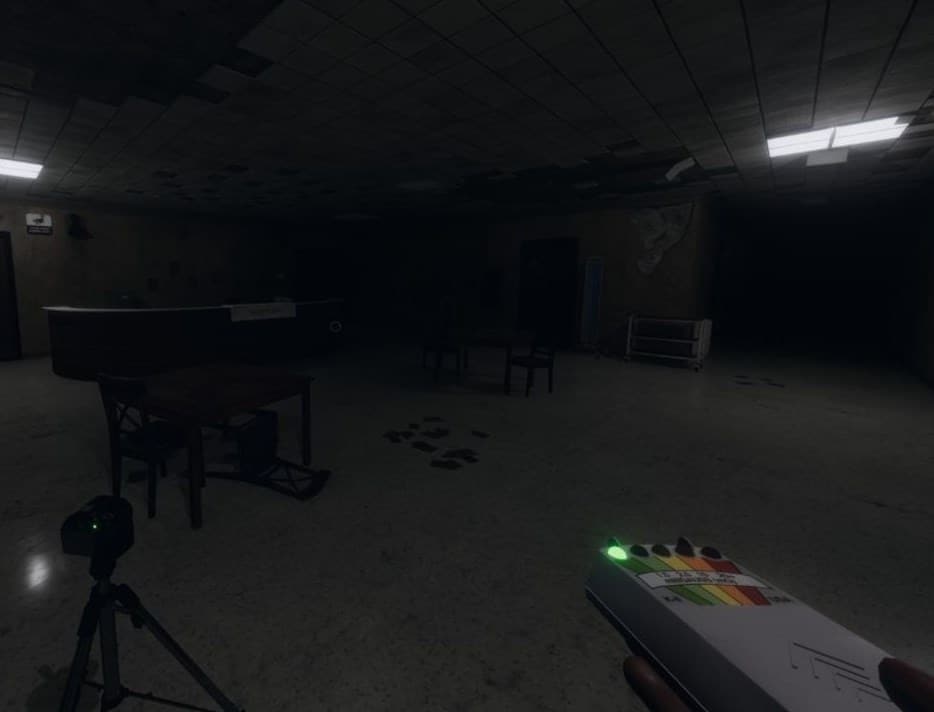
EMF Reader: A device that detects paranormal activity through fluctuations in electromagnetic fields. It’ll beep when you’ve found something, and there are five activity levels.
UV Flashlight: A special flashlight used to detect ghost fingerprints and footprints. Take pictures of the prints to get bonus money.
Photo Camera: It takes photos. Each camera holds a maximum of 5 pictures.
Video Camera: It records what it sees and sends it to the computer. The Video Camera lets you spot Ghost Orbs on it’s display or the computer.
Spirit Box: A small radio that lets you speak to the ghost by asking it questions.
Flashlight: It lets you see in the dark.
Ghost Writing Book: A journal that the ghost can write in. Take a picture of it for bonus money.
D.O.T.S Projector: Fills an area with green lights that can detect ghosts.
Other Gear
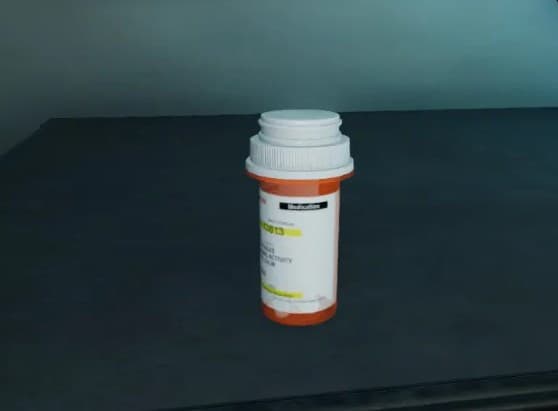
Strong Flashlight: a more powerful version of the standard Flashlight.
Sanity Pills: Restores some of your Sanity, which goes down as you spend time with the ghost. Once Sanity goes down to a certain point, the ghost can begin hunting, and it will hunt more often as it decreases.
Head-Mounted Camera: A video camera but on your head. Like a regular camera, the video feed can be seen on the computer.
Smudge Sticks: Used to cleanse an area, preventing ghosts from hunting.
Thermometer: Records the temperature in an area. It’s used to detect when a room is freezing.
Crucifix: Prevents some ghost types from hunting.
Salt Shaker: Allows you to place salt on the ground. Ghosts leave footprints in the salt.
Tripod: Used to rig the Video Camera in a room.
Candle: Used for light and an objective where the ghost puts it out.
Lighter: Lights Candles and Smudge Sticks. It also provides a bit of light.
Motion Sensor: Detects when ghosts or players pass by. Pings show up on the van’s map screen.
Parabolic Microphone: Detects sounds from the ghost in a large radius.
Sound Sensor: Detects nearby ghost sounds and sends the information to the van.
Glowstick: Used for UV light, like the UV Flashlight.
Cursed Objects
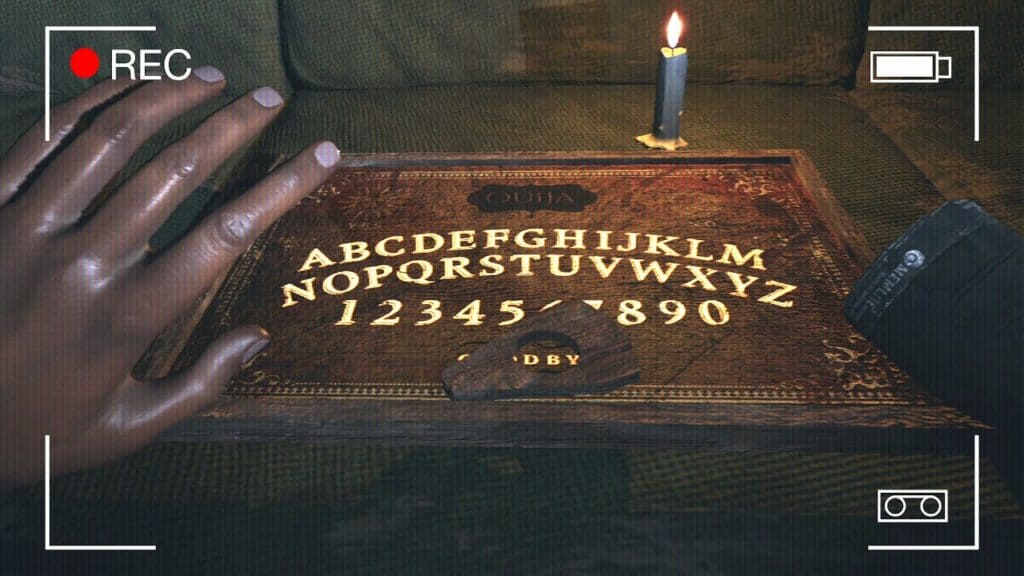
Bones: A bone from a person.
Ouija Board: Used to ask questions directly to the ghost. The ghost won’t always answer, and the board drains Sanity.
Haunted Mirror: A mirror that helps you find the ghost room but drains Sanity.
Summoning Circle: When lit, the circle summons the ghost and traps it in place, but only for a few seconds; the ghost will hunt afterward. It’s helpful if you want to take pictures of a ghost.
Voodoo Doll: Forces the ghost to interact or hunt.
Music Box: Causes the ghost to sing, making it easier to find.
Tarot Cards: A deck of random cards with different effects. These include:
- The Sun: Sanity is maxed out.
- The Moon: Sanity goes down to zero.
- The Tower: A ghost interaction occurs.
- The Wheel of Fortune: The player will either gain or lose sanity.
- The Devil: The player nearest to the ghost sees a Ghost Event.
- The High Priestess: A random player is revived.
- The Hanged Man: The player dies.
- Death: A cursed hunt begins.
- The Hermit: The ghost is trapped in the ghost room for a minute.
- The Fool: No effect.
Ghost Types

Ghosts in Phasmophobia start with random identities. Their name is randomly generated, and they will either respond to individual people or an entire room. Their behavior ranges from shy and difficult to spot to highly aggressive and dangerous, and the different types have certain behaviors that give away what kind of ghost they are.
Spirit: The everyday ghost. It doesn’t have any specific strengths or unique behaviors. It’s weaker to smudge sticks than other ghosts. I don’t think I’ve ever died to one, but I die a lot so take my words with a grain of salt.
Demon: Demons are aggressive predators and some of the most dangerous ghosts you’ll run into. They hunt frequently and relentlessly. The Demon hates Crucifixes and will gradually break them into pieces. To be honest, I’ve rarely ever survived a Demon since they attack so much that I can’t collect evidence in time.
Wraith: A ghost that rarely touches the ground and teleports near players randomly. Wraiths won’t leave any footprints, so if they step in salt and there’s no UV print, it’s probably one of these.
Jinn: A ghost that travels faster than other ghosts until it gets close to the player. If the power in an area is turned off, it can’t move faster. It would be best to stay far away from these guys and hide, so they don’t speed towards you.
Revenant: One of the most dangerous ghosts in the game. It hunts with extreme speed when it spots a potential victim. When it isn’t hunting, it moves slowly. If it gets aggressive, hide right away; they have often killed me because I was out in the open.
Poltergeist: A ghost type that throws objects everywhere like a toddler having a temper tantrum. Take away the objects, and it won’t be as aggressive. It can still hunt, so don’t assume it’s completely powerless without the random garbage.
Banshee: A ghost that hunts one player at a time. Its hunting patterns are a big giveaway since it’ll pursue one person until they die before moving on. It also makes a unique sound that registers on the Parabolic Microphone. The Parabolic Microphone isn’t needed to find a ghost in most cases, so I don’t use it that often.
Hantu: Hantus love the cold and move faster where the temperature is lower. On the other hand, they move slower where it’s warmer. Turning on the power helps moderate the temperature, so give it a try if you think the ghost is a Hantu.
Mare: The Mare fears the light. If the lights are off, it’s more likely to attack. It will constantly try to turn off the lights. Mares are annoying since every damn map is dark. It doesn’t help that I rarely try to turn on the lights.
Shade: Shades are self-conscious and like to hide from players. They usually only hunt one player at a time, so if multiple people are in a room, they won’t want to hunt. The hard part is finding it.
Oni: An Oni will be very active in an area and is often aggressive. That increased activity makes it easier to detect and difficult to escape from if it gets angry. In my experience, this one is a lot like a Demon, albeit not as deadly.
Phantom: A ghost that drops your Sanity level very quickly. Don’t look at it, and if you need it to disappear, take a photo of it. I’ve gotten killed by these often because I don’t usually know to look away.
Yurei: Like the Phantom, the Yurei drains Sanity quicker than other ghosts. Using Smudge Sticks in the ghost room can prevent it from wandering. It doesn’t need to be looked at to drain your Sanity, so if you notice a significant drop in a short time, it could be this ghost.
Myling: A Myling is a ghost that hunts quietly but makes a lot of noise when it isn’t hunting. If you get hunted, listen carefully and make sure it’s quiet.
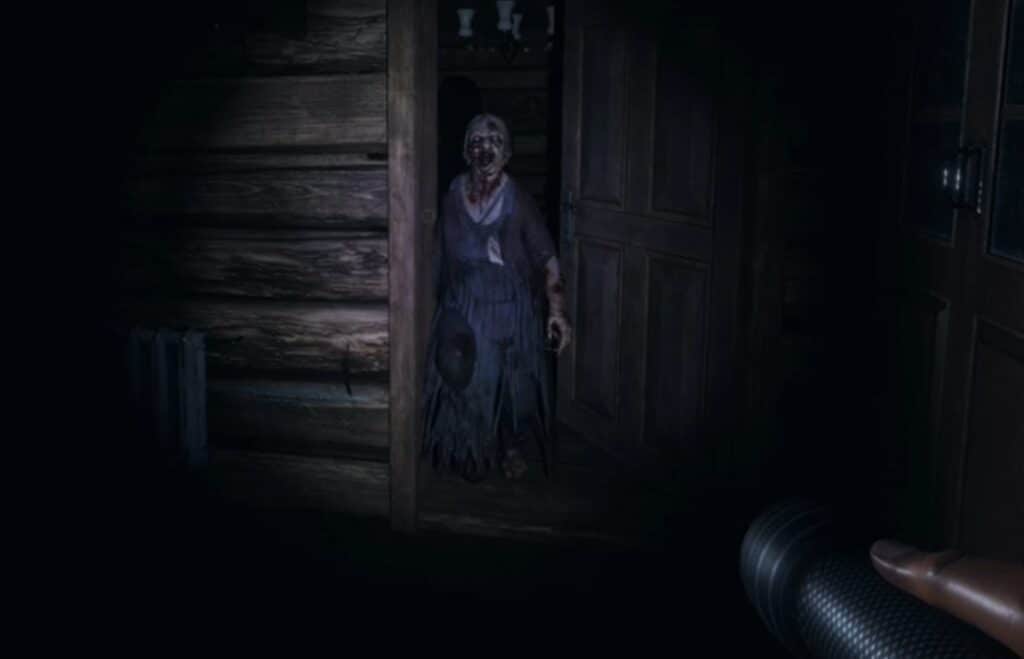
Yokai: Yokais hate when people talk and will attack if they hear players speaking. To avoid being hunted, stop running your mouth. Yokais can only hear from very close when they’re hunting, so if you’re quiet, you can escape easily.
Goryo: A ghost that can only be seen through a D.O.T.S Projector. It frequently stays in the ghost room, making it easy to collect evidence once the room is found.
Obake: An Obake sometimes leaves behind unique fingerprints with six fingers. These fingerprints disappear quickly, however.
Onryo: Onryos fear fire and are more likely to attack when it is extinguished. Lots of fire should be helpful, but don’t put it out.
Raiju: They like electricity and will become better hunters if they’re close to electrical devices. However, they constantly disrupt equipment, making them easy to discover.
The Mimic: A Mimic will try to imitate the traits of other ghost types, making it difficult to determine what type it is. Ghost Orbs show up near them often, but don’t let that confuse you; the orbs aren’t one of its main evidence types.
The Twins: Now there are two of them! They can start hunts and interact with an area separately and often try to confuse players with their movements. They sometimes interact with two different places in a map at once, so splitting up is an excellent way to find them.
Maps
Maps in Phasmophobia vary from small to large and labyrinthine. Most of the maps are small or medium, which is way better as far as I’m concerned. Hunting ghosts in a big map shrouded in darkness isn’t fun; assuming you aren’t scared of the ghost, it’s a tedious affair.
Small
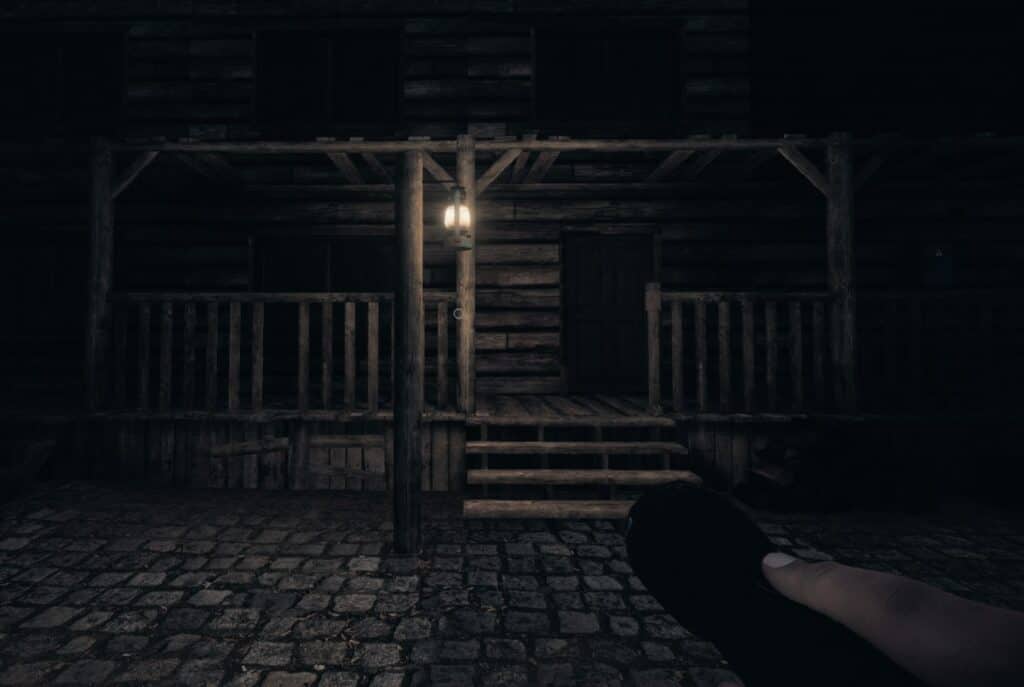
Bleasdale Farmhouse: One of two farmhouses in Phasmophobia. It has two floors and an attic, making it the bigger of the two. It has several bedrooms and bathrooms, meaning that it’s easier to hide but harder to find the ghost room.
Tanglewood Street House: A small, one-floor house. It has only a few rooms and is very open, making it easier to find the ghost room in this map than in bigger ones. However, it has relatively few hiding places, so you’ll die quickly if you aren’t careful. Tanglewood is one of my favorites since it isn’t too big but can still be challenging.
Edgefield Street House: A two-story house with tight spaces and plenty of rooms. What it lacks in open space, it makes up for in hiding spots; the house has lockers, closets, multiple bedrooms and bathrooms, and more. It’s a bit harder than Tanglewood but is manageably small.
Grafton Farmhouse: The other farmhouse variant. It’s smaller than Bleasdale, and in my opinion, it’s more fun. It has a large ground floor with bigger rooms and a tighter second floor with smaller rooms, so it’s got the best of both worlds. The main downside to this map is the ground floor; It has plenty of places to hide, but they’re spread out. This means that you won’t always be able to run to a good hiding spot, making you an easy target. I usually die on the ground floor for this reason.
Willow Street House: This house is one of the smallest maps in the game. It’s got two bedrooms and a single bathroom, and most of the time, you’ll be hunting for the ghost in the basement. There are very few hiding spots, but there are also very few places for the ghost to be. It’s a high-risk, high-reward situation; I find it exciting. If done correctly, the investigation can also be completed quickly.
Ridgeview Road House: Ridgeview is right in the middle of the smaller maps in terms of size. It isn’t the most open house map, but it has many rooms, a spacious basement, and two floors. It’s a great map to play on if you don’t want to risk being out in the open all the time. I see Ridgeview as a jack of all trades, a good option for investigators of all levels.
Medium
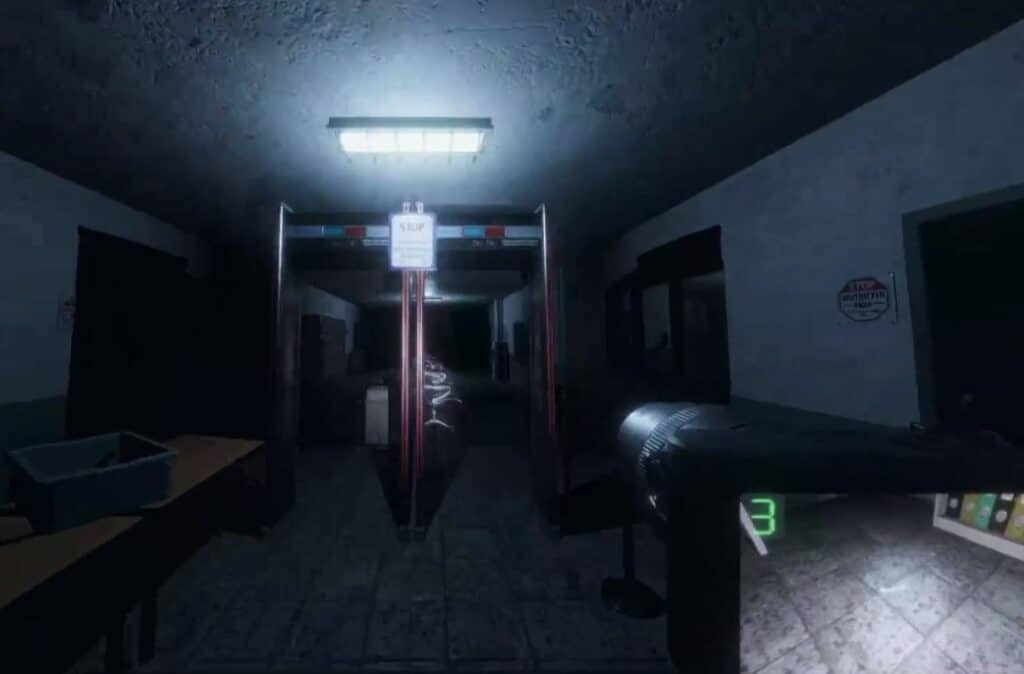
Prison: Now, here’s where things get complicated. The Prison is essentially the little brother to the Asylum, although I find it much more enjoyable. It’s got offices, two prison blocks, a medical wing, and various other rooms. The variety makes navigating it more straightforward, but the Prison can be complicated if you’re new. I know from experience that trying to stumble around a big prison with low Sanity is stressful.
Brownstone High School: Running this map is about as fun as high school. The layout is smaller and a little more manageable than the Prison, but I’ve rarely been successful here. Both sides of the school look identical, and the classrooms and bathrooms don’t provide many hiding spots. It also has multiple floors, is very dark, and the long hallways make it hard to run from a ghost that’s hunting.
Maple Lodge Campsite: I’d argue that the campsite is the most challenging map in the medium category. It isn’t as big as the high school or the prison, but most of the camp is outside, unlike other maps of its caliber. This makes hunting the ghost and escaping from it equally tricky because there are few rooms to enter and few hiding places. The layout is also confusing to navigate, and I’ve gotten lost almost every time I’ve run it. To be fair, I haven’t run it that many times since I think it sucks.
Large
Asylum: The big bad of Phasmophobia isn’t the Demon or the Revenant or even the Maple Lodge Campsite. It’s the Asylum, a labyrinth with identical hallways, over a hundred rooms with relatively few hiding spaces, and two floors. I’ve gotten lost in here every time I’ve run it, and I’ve rarely ever made it out. Assuming you can handle the ghost (or even find it), you’ll likely be trapped inside and short on Sanity, meaning that you’ll be hunted relentlessly. If you want to enter the Asylum, be ready for a serious challenge. If I were you, I’d just play a better map.
Rewards
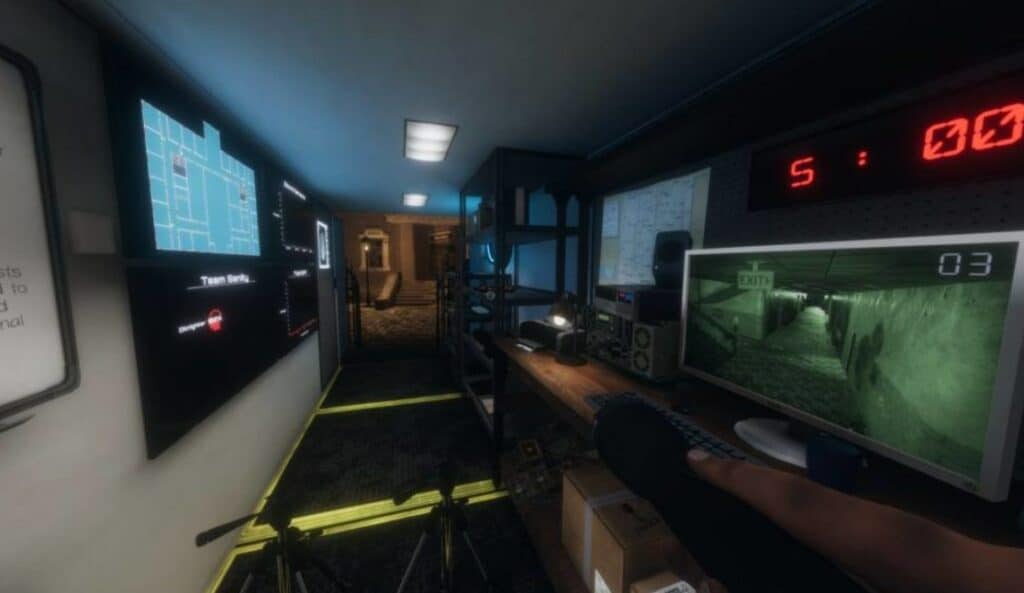
Don’t let the notion that you’re working for minimum wage discourage you; the rewards will improve as you make your way up the professional ghost hunting ladder. You’ll just have to be good at your job and not die. Simple! Here’s how you can make some cash.
Objectives
Your best bet for a good payout is to complete the optional objectives. The whiteboard in the truck will tell you what they are. The objectives sometimes contribute to the evidence types you’ll need to find the ghost, but most of the time, they’ll be extra tasks that will add a bit of a challenge. Things like getting the ghost to step on salt, taking a photo of it, or escaping a hunt are all examples of tasks you’ll have to do.
Difficulty
A great way to make more money is to increase the game’s difficulty. The higher the difficulty, the more money you’ll get after a successful search. The increase is pretty drastic, so I highly recommend this course of action. I usually take on Professional jobs because they give you good money while not being extremely hard like the newer Nightmare difficulty is. If you’re new to Phasmophobia, start on an easier difficulty and work your way up until you’re comfortable.
Photos
You can take photos of various things during a game and get extra cash rewards. You’ll get stars depending on how close or far you are from what you’re photographing. The most you can get is three; this will net you the most points and therefore the most money.
- The ghost
- Various ghost interactions, such as Ghost Writing, floating objects, and a moving Ouija Board
- Bones
- Dirty Water
- Dead Bodies
- Fingerprints/Footprints
- Cursed Objects, such as the Ouija Board, Tarot Cards, or the Haunted Mirror
The photo that’ll get you the most points is a close-up of the ghost. For obvious reasons, this can be pretty hard to pull off.
FAQ
Question: Is There a Definitive way to Find Ghosts?
Answer: It largely depends on the map, the ghost type, and your playstyle. There aren’t really any hacks, so be prepared to get it wrong! Even the most experienced investigators make mistakes. Just remember that it’ll become easier to detect specific patterns as you get better.
Question: Is it Better to Play Phasmophobia on VR or Desktop?
Answer: I recommend playing it on VR. It’s exciting and immersive in ways that the standard game isn’t, with unique benefits. However, if you’re easily scared, you should stick to the desktop version. Being hunted by a ghost is scarier when you’re actually there.
Question: Should I Play on my Own or with Other People?
Answer: You’ll usually be more successful and have a better time if you play with other people. If you play solo, you’re forced to collect all the evidence types while being the sole target of the ghost; this makes the game tougher by default. If you’re easily scared, it’s better to be scared with someone else than alone.
Question: How Many People Should I Play With?
Answer: Phasmophobia is usually easier if you have a full team. However, you shouldn’t feel pressured to hire three people every time you play. Just one other person will make a big difference. I frequently play with one friend, and we’ve been pretty successful. Just follow your heart, and you’ll be fine.
Conclusion
Now you should be up to speed on the job. Take the information you’ve learned and be the best pre-Ghostbuster you can! Just in case you’re new and find all this to be confusing, give it time. You’ll figure out your rhythm as you keep playing, and you won’t need to use every single equipment type in any situation.
Here’s an idea: most players like to take a specific gear set when they start a game. I personally love to use this loadout: the UV Light, the Strong Flashlight, the Photo Camera, and sometimes the Head-Mounted Camera. Try picking a loadout you like, and make the experience uniquely yours. You can even try speaking to the ghost in unique ways. For example, many people like to swear at the ghost until it gets angry and attacks. It’s a lot of fun!
Continue reading:
Resident Evil 7 Biohazard VR Guide
